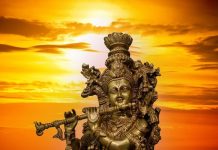
Janmashtami, the auspicious Hindu festival celebrating the birth of Lord Krishna, is a time of both spiritual reflection and joyous celebration. Fasting and feasting are integral aspects of this festival, with devotees observing fasts during the day and indulging in delicious, vegetarian feasts at midnight. In this article, we’ll explore the significance of fasting and feasting during Janmashtami and provide some traditional recipes that add flavor to this festive occasion.
Fasting on Janmashtami: A Spiritual Detox
Fasting on Janmashtami is a way for devotees to purify their bodies and minds in preparation for the midnight celebration of Lord Krishna’s birth. The fast typically involves abstaining from grains, pulses, and non-vegetarian food, with some devotees refraining from consuming water as well. The fast is observed from sunrise until midnight, when Lord Krishna is believed to have been born.
Breaking the Fast: Midnight Celebrations
The most awaited moment of Janmashtami is the midnight celebration of Lord Krishna’s birth, known as “Nanda Utsav.” Devotees gather in temples and homes to sing devotional songs, dance, and perform puja (ritual worship) at the precise moment of Krishna’s birth. Following this, the fast is broken with a grand feast that includes a variety of delectable dishes, many of which are prepared without grains.
Traditional Janmashtami Recipes: A Gastronomic Delight
1. Makhan Mishri: A simple yet divine dish made from freshly churned butter (makhan) and crystallized sugar (mishri). It symbolizes Lord Krishna’s love for butter and is offered to the deity before being distributed to devotees.
2. Panjiri: A sweet and nutritious dish prepared from whole wheat flour, ghee (clarified butter), sugar, and dry fruits. Panjiri is an essential Janmashtami offering, signifying the sweetness of devotion.
3. Sabudana Khichdi: A popular fasting dish made from tapioca pearls (sabudana), peanuts, and spices. It’s a staple during Janmashtami fasting, providing energy and sustenance throughout the day.
4. Aloo Ka Halwa: A comforting sweet dish made from boiled and mashed potatoes, sugar, and ghee. This halwa is rich and hearty, perfect for breaking the fast.
5. Fruit Chaat: A refreshing fruit salad featuring a mix of seasonal fruits, often garnished with a sprinkle of rock salt and black pepper for a tangy twist.
6. Sabudana Kheer: A creamy and aromatic dessert made from sabudana, milk, sugar, and cardamom. It’s a delightful way to conclude the Janmashtami feast.
Conclusion: Celebrate Janmashtami with Fasting and Feasting
Janmashtami offers a unique blend of spiritual observance and culinary delight. Fasting on this day is a form of devotion and self-purification, while the midnight feast symbolizes the joyous arrival of Lord Krishna. Traditional recipes add flavor to the festivities, and preparing and sharing these dishes with loved ones is an integral part of celebrating Janmashtami, fostering a sense of togetherness and devotion to Lord Krishna.
























































